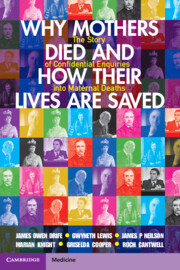 Why Mothers Died and How their Lives are Saved
Why Mothers Died and How their Lives are Saved Published online by Cambridge University Press: 05 April 2023
Indirect deaths result from diseases made worse by pregnancy. Their importance increased as reporting improved. In 1991 Michael de Swiet became the medical assessor to the Enquiries. Initially heart disease was the main concern. Rheumatic heart disease may follow streptococcal rheumatic fever. Women can live with it but pregnancy puts a strain on the heart and death may occur during childbirth. In 1952-4 the deaths from heart disease included 37 women giving birth at home. The disease diminished due to penicillin and better social conditions. Women with congenital heart disease were warned against pregnancy but cardiac surgery reduced the risk and obstetricians learned to work with cardiologists. The pattern of disease changed due to smoking and obesity, and myocardial infarction became the main cause of cardiac death. After 1997-9 Indirect deaths outnumbered Direct deaths. Reports highlighted the inadequate management of epilepsy, with poor communication between maternity carers and neurologists, particularly for women in deprived circumstances. The Enquiries’ findings helped to create a new specialty and the Obstetric Medicine Society now runs its own training programme.
To save this book to your Kindle, first ensure [email protected] is added to your Approved Personal Document E-mail List under your Personal Document Settings on the Manage Your Content and Devices page of your Amazon account. Then enter the ‘name’ part of your Kindle email address below. Find out more about saving to your Kindle.
Note you can select to save to either the @free.kindle.com or @kindle.com variations. ‘@free.kindle.com’ emails are free but can only be saved to your device when it is connected to wi-fi. ‘@kindle.com’ emails can be delivered even when you are not connected to wi-fi, but note that service fees apply.
Find out more about the Kindle Personal Document Service.
To save content items to your account, please confirm that you agree to abide by our usage policies. If this is the first time you use this feature, you will be asked to authorise Cambridge Core to connect with your account. Find out more about saving content to Dropbox.
To save content items to your account, please confirm that you agree to abide by our usage policies. If this is the first time you use this feature, you will be asked to authorise Cambridge Core to connect with your account. Find out more about saving content to Google Drive.